Human Resource Management Report: The Savoy Hotel, UK
VerifiedAdded on 2022/08/26
|10
|2665
|20
Report
AI Summary
This report provides an in-depth analysis of Human Resource Management (HRM) practices at The Savoy Hotel in the UK. It begins by exploring various training and learning methods and techniques, including classroom training, interactive methods, and hands-on training, emphasizing their importance in enhancing employee skills and customer service. The report then delves into learning and development strategies, highlighting their role in attracting and retaining talent, building a value-based culture, and improving productivity within the hospitality industry. Furthermore, the report examines performance management, discussing its significance in setting expectations, providing feedback, and achieving organizational objectives. It also covers the legal aspects of HRM, including employment legislation, data protection, anti-discrimination laws, and labor laws, which are crucial for the hotel's success. The report concludes by summarizing the key findings and emphasizing the importance of effective HRM practices for the hotel's overall performance and service quality.
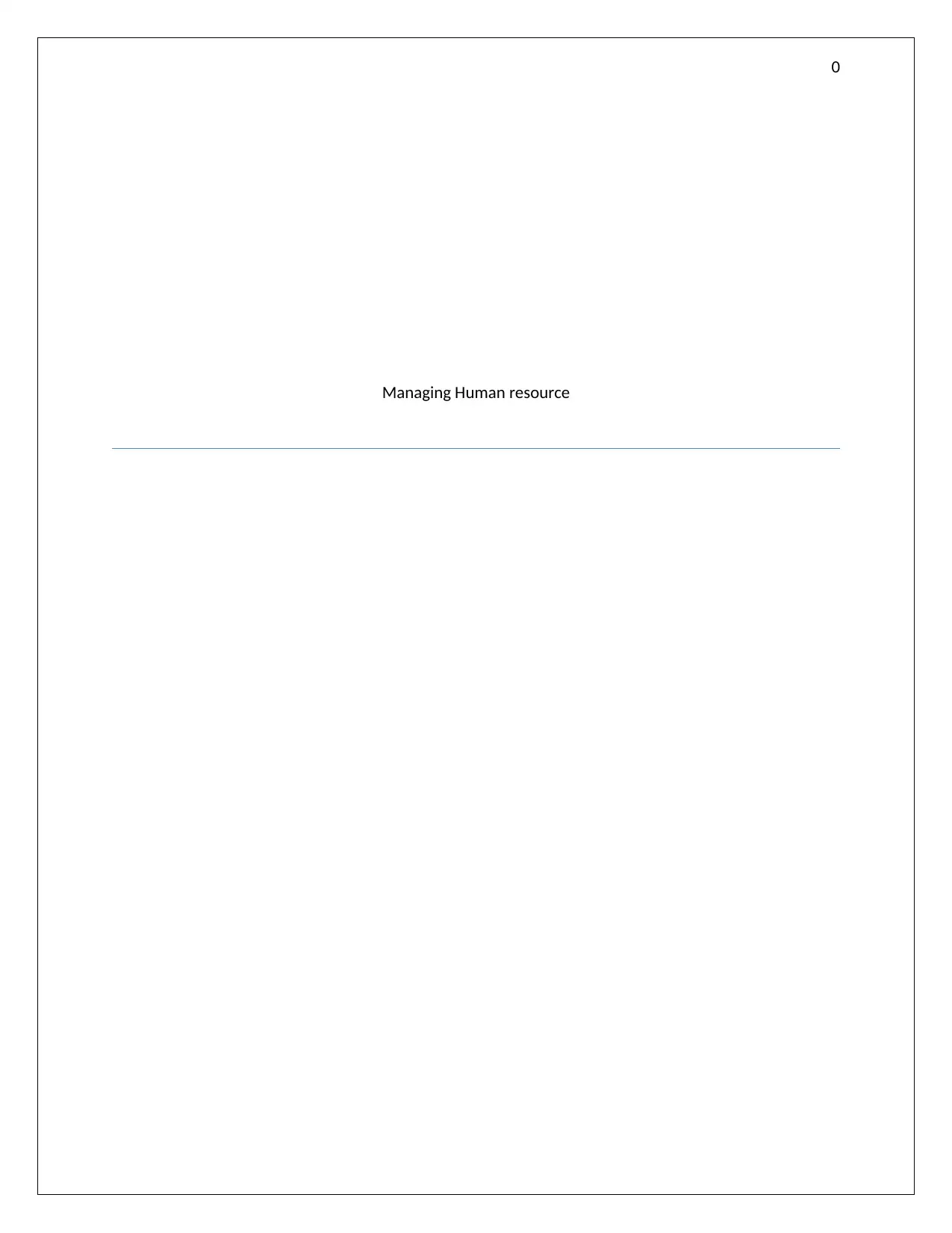
0
Managing Human resource
Managing Human resource
Paraphrase This Document
Need a fresh take? Get an instant paraphrase of this document with our AI Paraphraser
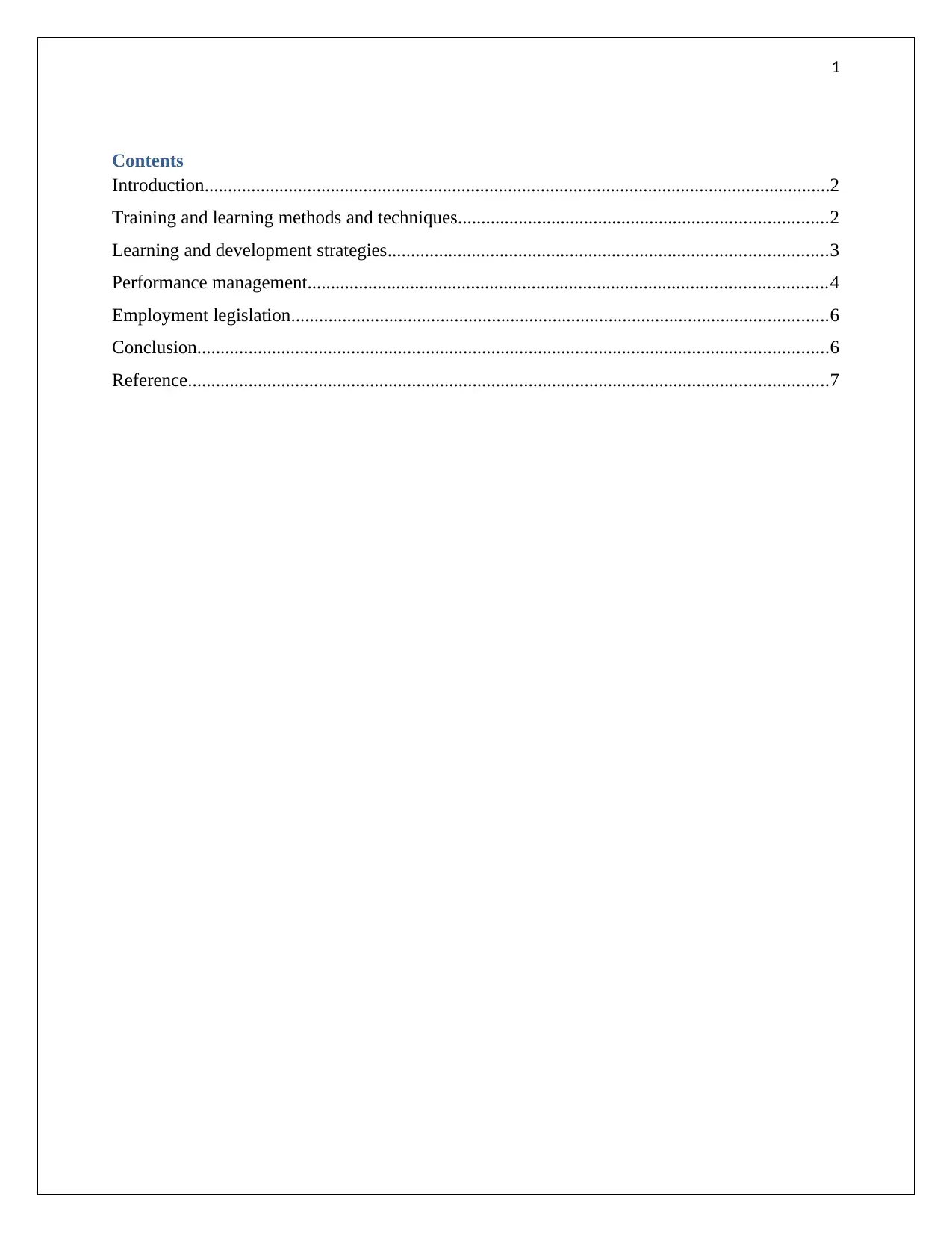
1
Contents
Introduction......................................................................................................................................2
Training and learning methods and techniques...............................................................................2
Learning and development strategies..............................................................................................3
Performance management...............................................................................................................4
Employment legislation...................................................................................................................6
Conclusion.......................................................................................................................................6
Reference.........................................................................................................................................7
Contents
Introduction......................................................................................................................................2
Training and learning methods and techniques...............................................................................2
Learning and development strategies..............................................................................................3
Performance management...............................................................................................................4
Employment legislation...................................................................................................................6
Conclusion.......................................................................................................................................6
Reference.........................................................................................................................................7
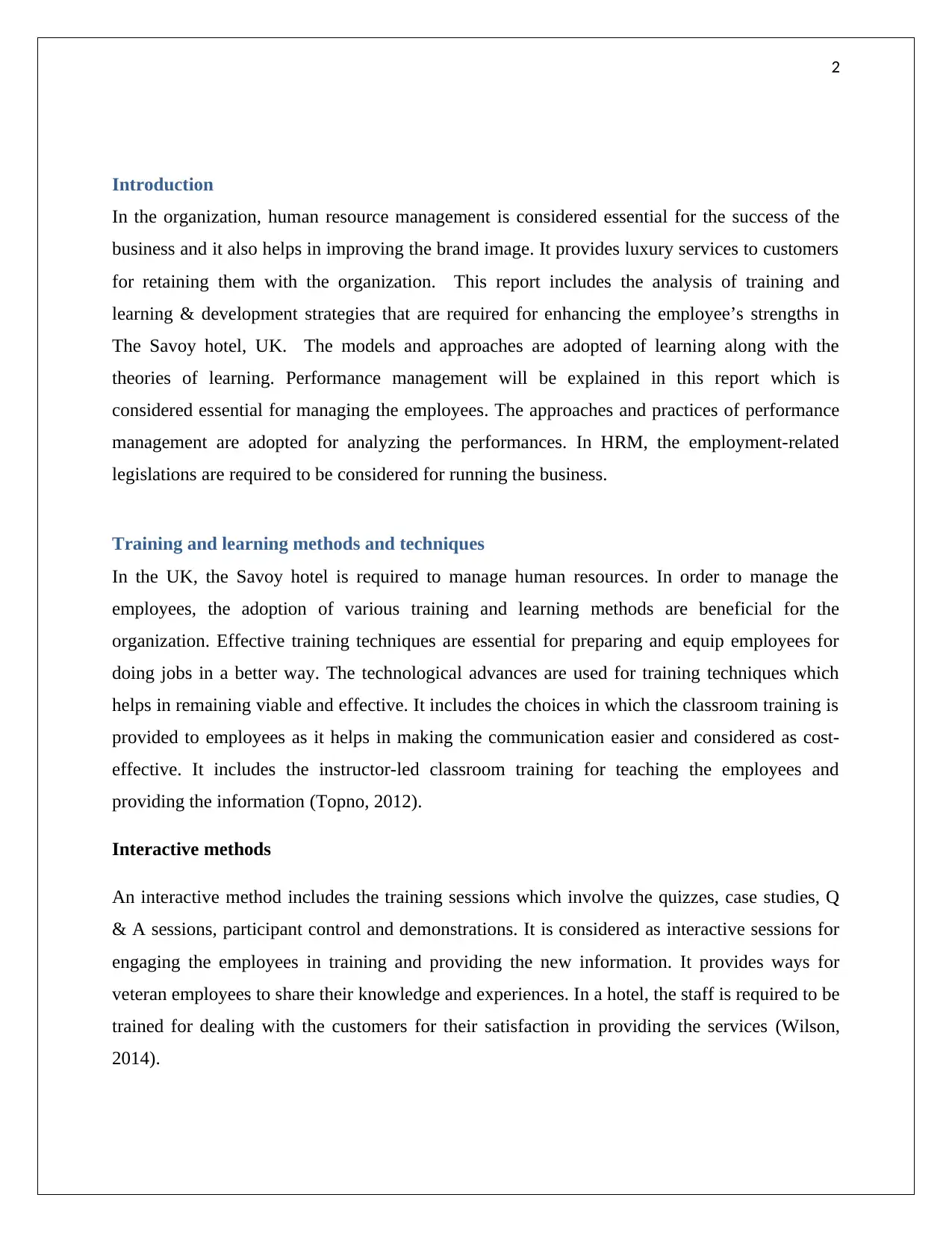
2
Introduction
In the organization, human resource management is considered essential for the success of the
business and it also helps in improving the brand image. It provides luxury services to customers
for retaining them with the organization. This report includes the analysis of training and
learning & development strategies that are required for enhancing the employee’s strengths in
The Savoy hotel, UK. The models and approaches are adopted of learning along with the
theories of learning. Performance management will be explained in this report which is
considered essential for managing the employees. The approaches and practices of performance
management are adopted for analyzing the performances. In HRM, the employment-related
legislations are required to be considered for running the business.
Training and learning methods and techniques
In the UK, the Savoy hotel is required to manage human resources. In order to manage the
employees, the adoption of various training and learning methods are beneficial for the
organization. Effective training techniques are essential for preparing and equip employees for
doing jobs in a better way. The technological advances are used for training techniques which
helps in remaining viable and effective. It includes the choices in which the classroom training is
provided to employees as it helps in making the communication easier and considered as cost-
effective. It includes the instructor-led classroom training for teaching the employees and
providing the information (Topno, 2012).
Interactive methods
An interactive method includes the training sessions which involve the quizzes, case studies, Q
& A sessions, participant control and demonstrations. It is considered as interactive sessions for
engaging the employees in training and providing the new information. It provides ways for
veteran employees to share their knowledge and experiences. In a hotel, the staff is required to be
trained for dealing with the customers for their satisfaction in providing the services (Wilson,
2014).
Introduction
In the organization, human resource management is considered essential for the success of the
business and it also helps in improving the brand image. It provides luxury services to customers
for retaining them with the organization. This report includes the analysis of training and
learning & development strategies that are required for enhancing the employee’s strengths in
The Savoy hotel, UK. The models and approaches are adopted of learning along with the
theories of learning. Performance management will be explained in this report which is
considered essential for managing the employees. The approaches and practices of performance
management are adopted for analyzing the performances. In HRM, the employment-related
legislations are required to be considered for running the business.
Training and learning methods and techniques
In the UK, the Savoy hotel is required to manage human resources. In order to manage the
employees, the adoption of various training and learning methods are beneficial for the
organization. Effective training techniques are essential for preparing and equip employees for
doing jobs in a better way. The technological advances are used for training techniques which
helps in remaining viable and effective. It includes the choices in which the classroom training is
provided to employees as it helps in making the communication easier and considered as cost-
effective. It includes the instructor-led classroom training for teaching the employees and
providing the information (Topno, 2012).
Interactive methods
An interactive method includes the training sessions which involve the quizzes, case studies, Q
& A sessions, participant control and demonstrations. It is considered as interactive sessions for
engaging the employees in training and providing the new information. It provides ways for
veteran employees to share their knowledge and experiences. In a hotel, the staff is required to be
trained for dealing with the customers for their satisfaction in providing the services (Wilson,
2014).
⊘ This is a preview!⊘
Do you want full access?
Subscribe today to unlock all pages.

Trusted by 1+ million students worldwide
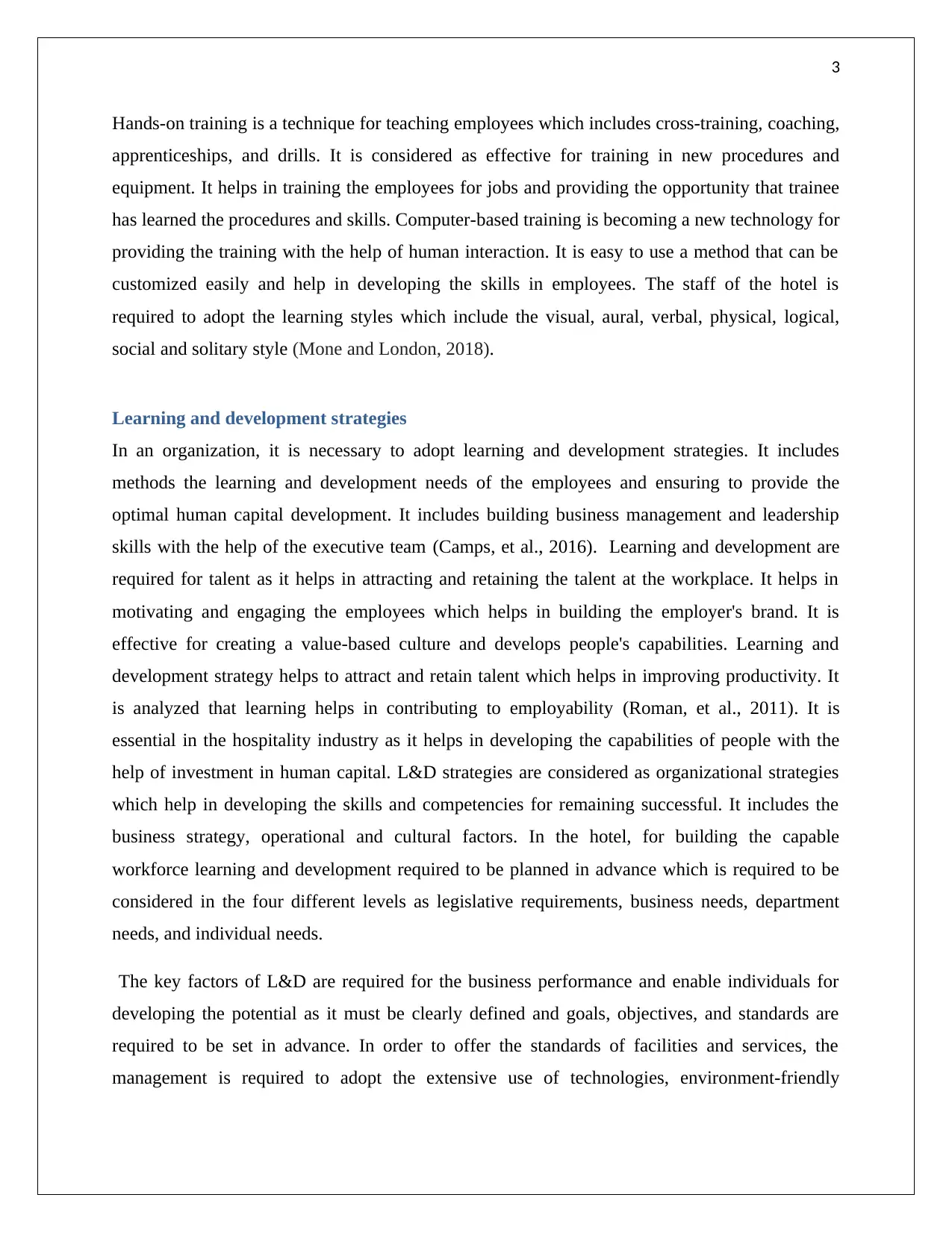
3
Hands-on training is a technique for teaching employees which includes cross-training, coaching,
apprenticeships, and drills. It is considered as effective for training in new procedures and
equipment. It helps in training the employees for jobs and providing the opportunity that trainee
has learned the procedures and skills. Computer-based training is becoming a new technology for
providing the training with the help of human interaction. It is easy to use a method that can be
customized easily and help in developing the skills in employees. The staff of the hotel is
required to adopt the learning styles which include the visual, aural, verbal, physical, logical,
social and solitary style (Mone and London, 2018).
Learning and development strategies
In an organization, it is necessary to adopt learning and development strategies. It includes
methods the learning and development needs of the employees and ensuring to provide the
optimal human capital development. It includes building business management and leadership
skills with the help of the executive team (Camps, et al., 2016). Learning and development are
required for talent as it helps in attracting and retaining the talent at the workplace. It helps in
motivating and engaging the employees which helps in building the employer's brand. It is
effective for creating a value-based culture and develops people's capabilities. Learning and
development strategy helps to attract and retain talent which helps in improving productivity. It
is analyzed that learning helps in contributing to employability (Roman, et al., 2011). It is
essential in the hospitality industry as it helps in developing the capabilities of people with the
help of investment in human capital. L&D strategies are considered as organizational strategies
which help in developing the skills and competencies for remaining successful. It includes the
business strategy, operational and cultural factors. In the hotel, for building the capable
workforce learning and development required to be planned in advance which is required to be
considered in the four different levels as legislative requirements, business needs, department
needs, and individual needs.
The key factors of L&D are required for the business performance and enable individuals for
developing the potential as it must be clearly defined and goals, objectives, and standards are
required to be set in advance. In order to offer the standards of facilities and services, the
management is required to adopt the extensive use of technologies, environment-friendly
Hands-on training is a technique for teaching employees which includes cross-training, coaching,
apprenticeships, and drills. It is considered as effective for training in new procedures and
equipment. It helps in training the employees for jobs and providing the opportunity that trainee
has learned the procedures and skills. Computer-based training is becoming a new technology for
providing the training with the help of human interaction. It is easy to use a method that can be
customized easily and help in developing the skills in employees. The staff of the hotel is
required to adopt the learning styles which include the visual, aural, verbal, physical, logical,
social and solitary style (Mone and London, 2018).
Learning and development strategies
In an organization, it is necessary to adopt learning and development strategies. It includes
methods the learning and development needs of the employees and ensuring to provide the
optimal human capital development. It includes building business management and leadership
skills with the help of the executive team (Camps, et al., 2016). Learning and development are
required for talent as it helps in attracting and retaining the talent at the workplace. It helps in
motivating and engaging the employees which helps in building the employer's brand. It is
effective for creating a value-based culture and develops people's capabilities. Learning and
development strategy helps to attract and retain talent which helps in improving productivity. It
is analyzed that learning helps in contributing to employability (Roman, et al., 2011). It is
essential in the hospitality industry as it helps in developing the capabilities of people with the
help of investment in human capital. L&D strategies are considered as organizational strategies
which help in developing the skills and competencies for remaining successful. It includes the
business strategy, operational and cultural factors. In the hotel, for building the capable
workforce learning and development required to be planned in advance which is required to be
considered in the four different levels as legislative requirements, business needs, department
needs, and individual needs.
The key factors of L&D are required for the business performance and enable individuals for
developing the potential as it must be clearly defined and goals, objectives, and standards are
required to be set in advance. In order to offer the standards of facilities and services, the
management is required to adopt the extensive use of technologies, environment-friendly
Paraphrase This Document
Need a fresh take? Get an instant paraphrase of this document with our AI Paraphraser
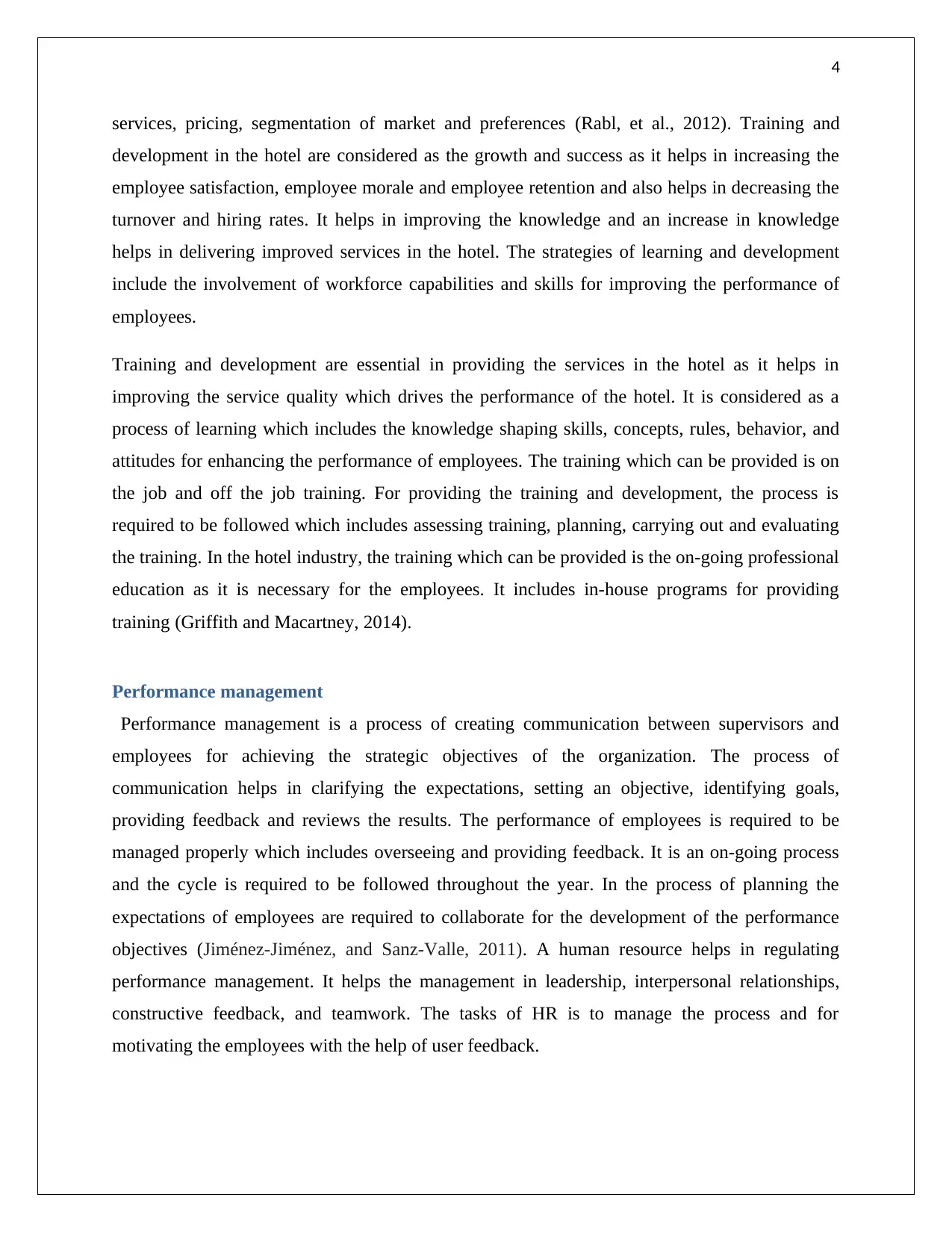
4
services, pricing, segmentation of market and preferences (Rabl, et al., 2012). Training and
development in the hotel are considered as the growth and success as it helps in increasing the
employee satisfaction, employee morale and employee retention and also helps in decreasing the
turnover and hiring rates. It helps in improving the knowledge and an increase in knowledge
helps in delivering improved services in the hotel. The strategies of learning and development
include the involvement of workforce capabilities and skills for improving the performance of
employees.
Training and development are essential in providing the services in the hotel as it helps in
improving the service quality which drives the performance of the hotel. It is considered as a
process of learning which includes the knowledge shaping skills, concepts, rules, behavior, and
attitudes for enhancing the performance of employees. The training which can be provided is on
the job and off the job training. For providing the training and development, the process is
required to be followed which includes assessing training, planning, carrying out and evaluating
the training. In the hotel industry, the training which can be provided is the on-going professional
education as it is necessary for the employees. It includes in-house programs for providing
training (Griffith and Macartney, 2014).
Performance management
Performance management is a process of creating communication between supervisors and
employees for achieving the strategic objectives of the organization. The process of
communication helps in clarifying the expectations, setting an objective, identifying goals,
providing feedback and reviews the results. The performance of employees is required to be
managed properly which includes overseeing and providing feedback. It is an on-going process
and the cycle is required to be followed throughout the year. In the process of planning the
expectations of employees are required to collaborate for the development of the performance
objectives (Jiménez-Jiménez, and Sanz-Valle, 2011). A human resource helps in regulating
performance management. It helps the management in leadership, interpersonal relationships,
constructive feedback, and teamwork. The tasks of HR is to manage the process and for
motivating the employees with the help of user feedback.
services, pricing, segmentation of market and preferences (Rabl, et al., 2012). Training and
development in the hotel are considered as the growth and success as it helps in increasing the
employee satisfaction, employee morale and employee retention and also helps in decreasing the
turnover and hiring rates. It helps in improving the knowledge and an increase in knowledge
helps in delivering improved services in the hotel. The strategies of learning and development
include the involvement of workforce capabilities and skills for improving the performance of
employees.
Training and development are essential in providing the services in the hotel as it helps in
improving the service quality which drives the performance of the hotel. It is considered as a
process of learning which includes the knowledge shaping skills, concepts, rules, behavior, and
attitudes for enhancing the performance of employees. The training which can be provided is on
the job and off the job training. For providing the training and development, the process is
required to be followed which includes assessing training, planning, carrying out and evaluating
the training. In the hotel industry, the training which can be provided is the on-going professional
education as it is necessary for the employees. It includes in-house programs for providing
training (Griffith and Macartney, 2014).
Performance management
Performance management is a process of creating communication between supervisors and
employees for achieving the strategic objectives of the organization. The process of
communication helps in clarifying the expectations, setting an objective, identifying goals,
providing feedback and reviews the results. The performance of employees is required to be
managed properly which includes overseeing and providing feedback. It is an on-going process
and the cycle is required to be followed throughout the year. In the process of planning the
expectations of employees are required to collaborate for the development of the performance
objectives (Jiménez-Jiménez, and Sanz-Valle, 2011). A human resource helps in regulating
performance management. It helps the management in leadership, interpersonal relationships,
constructive feedback, and teamwork. The tasks of HR is to manage the process and for
motivating the employees with the help of user feedback.
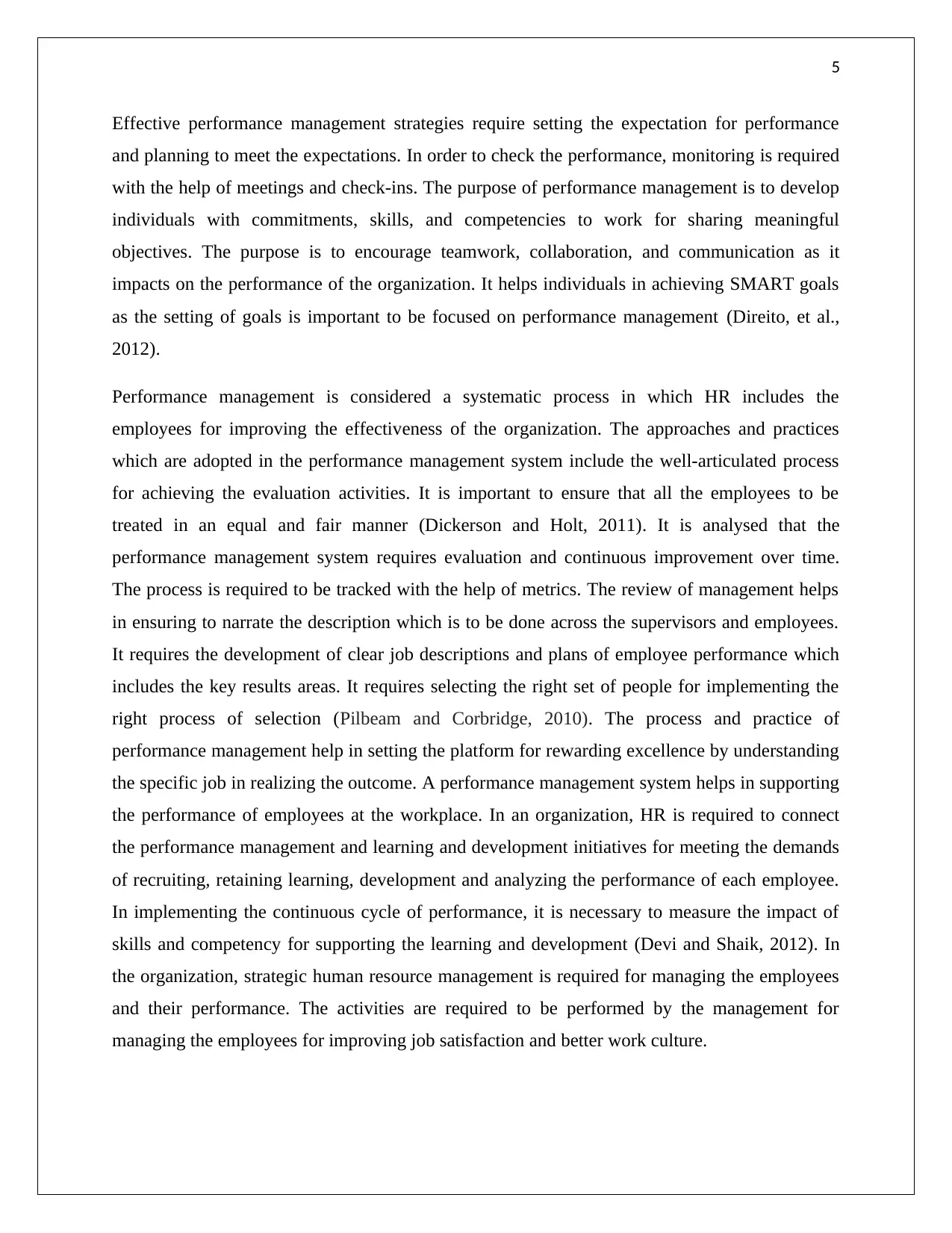
5
Effective performance management strategies require setting the expectation for performance
and planning to meet the expectations. In order to check the performance, monitoring is required
with the help of meetings and check-ins. The purpose of performance management is to develop
individuals with commitments, skills, and competencies to work for sharing meaningful
objectives. The purpose is to encourage teamwork, collaboration, and communication as it
impacts on the performance of the organization. It helps individuals in achieving SMART goals
as the setting of goals is important to be focused on performance management (Direito, et al.,
2012).
Performance management is considered a systematic process in which HR includes the
employees for improving the effectiveness of the organization. The approaches and practices
which are adopted in the performance management system include the well-articulated process
for achieving the evaluation activities. It is important to ensure that all the employees to be
treated in an equal and fair manner (Dickerson and Holt, 2011). It is analysed that the
performance management system requires evaluation and continuous improvement over time.
The process is required to be tracked with the help of metrics. The review of management helps
in ensuring to narrate the description which is to be done across the supervisors and employees.
It requires the development of clear job descriptions and plans of employee performance which
includes the key results areas. It requires selecting the right set of people for implementing the
right process of selection (Pilbeam and Corbridge, 2010). The process and practice of
performance management help in setting the platform for rewarding excellence by understanding
the specific job in realizing the outcome. A performance management system helps in supporting
the performance of employees at the workplace. In an organization, HR is required to connect
the performance management and learning and development initiatives for meeting the demands
of recruiting, retaining learning, development and analyzing the performance of each employee.
In implementing the continuous cycle of performance, it is necessary to measure the impact of
skills and competency for supporting the learning and development (Devi and Shaik, 2012). In
the organization, strategic human resource management is required for managing the employees
and their performance. The activities are required to be performed by the management for
managing the employees for improving job satisfaction and better work culture.
Effective performance management strategies require setting the expectation for performance
and planning to meet the expectations. In order to check the performance, monitoring is required
with the help of meetings and check-ins. The purpose of performance management is to develop
individuals with commitments, skills, and competencies to work for sharing meaningful
objectives. The purpose is to encourage teamwork, collaboration, and communication as it
impacts on the performance of the organization. It helps individuals in achieving SMART goals
as the setting of goals is important to be focused on performance management (Direito, et al.,
2012).
Performance management is considered a systematic process in which HR includes the
employees for improving the effectiveness of the organization. The approaches and practices
which are adopted in the performance management system include the well-articulated process
for achieving the evaluation activities. It is important to ensure that all the employees to be
treated in an equal and fair manner (Dickerson and Holt, 2011). It is analysed that the
performance management system requires evaluation and continuous improvement over time.
The process is required to be tracked with the help of metrics. The review of management helps
in ensuring to narrate the description which is to be done across the supervisors and employees.
It requires the development of clear job descriptions and plans of employee performance which
includes the key results areas. It requires selecting the right set of people for implementing the
right process of selection (Pilbeam and Corbridge, 2010). The process and practice of
performance management help in setting the platform for rewarding excellence by understanding
the specific job in realizing the outcome. A performance management system helps in supporting
the performance of employees at the workplace. In an organization, HR is required to connect
the performance management and learning and development initiatives for meeting the demands
of recruiting, retaining learning, development and analyzing the performance of each employee.
In implementing the continuous cycle of performance, it is necessary to measure the impact of
skills and competency for supporting the learning and development (Devi and Shaik, 2012). In
the organization, strategic human resource management is required for managing the employees
and their performance. The activities are required to be performed by the management for
managing the employees for improving job satisfaction and better work culture.
⊘ This is a preview!⊘
Do you want full access?
Subscribe today to unlock all pages.

Trusted by 1+ million students worldwide
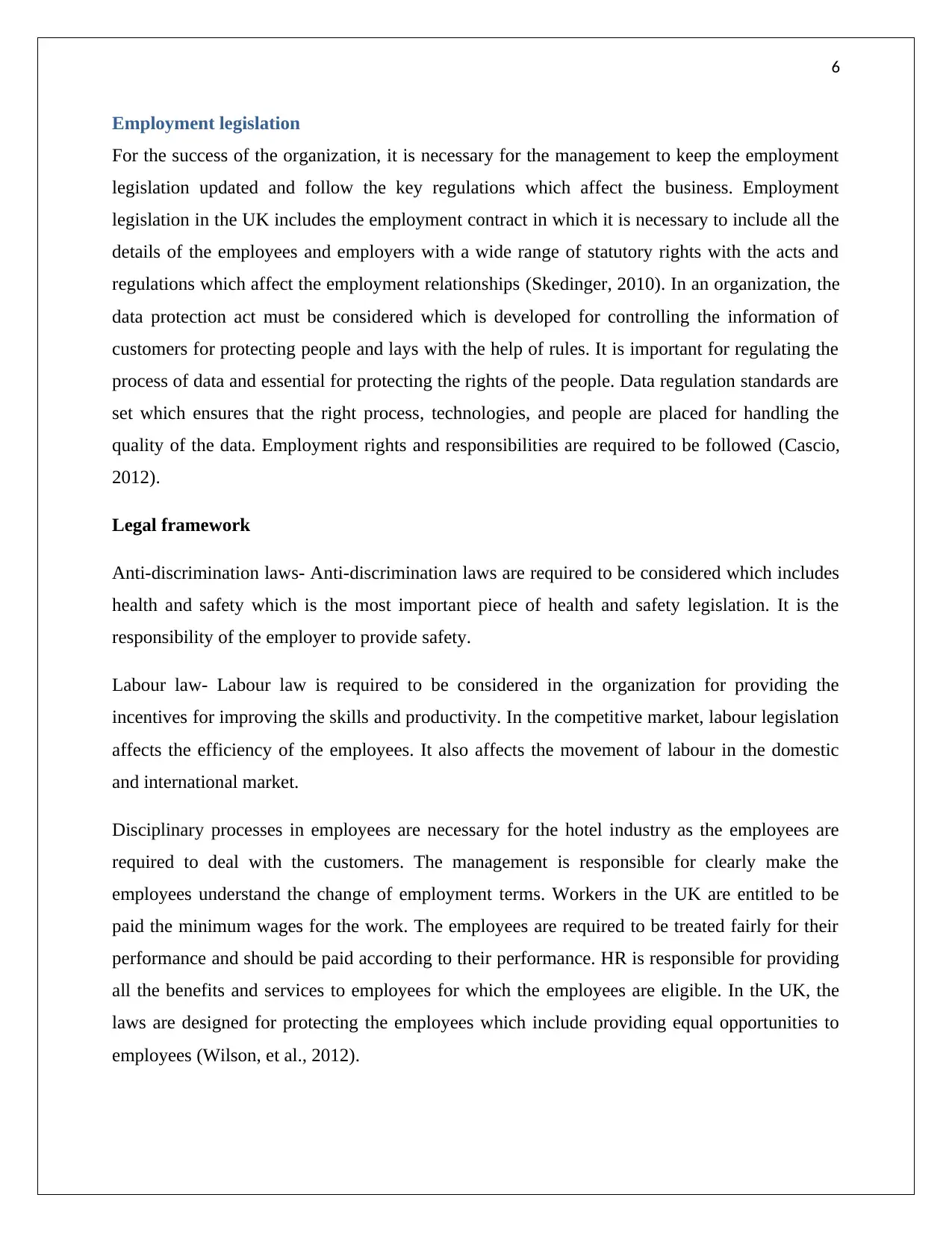
6
Employment legislation
For the success of the organization, it is necessary for the management to keep the employment
legislation updated and follow the key regulations which affect the business. Employment
legislation in the UK includes the employment contract in which it is necessary to include all the
details of the employees and employers with a wide range of statutory rights with the acts and
regulations which affect the employment relationships (Skedinger, 2010). In an organization, the
data protection act must be considered which is developed for controlling the information of
customers for protecting people and lays with the help of rules. It is important for regulating the
process of data and essential for protecting the rights of the people. Data regulation standards are
set which ensures that the right process, technologies, and people are placed for handling the
quality of the data. Employment rights and responsibilities are required to be followed (Cascio,
2012).
Legal framework
Anti-discrimination laws- Anti-discrimination laws are required to be considered which includes
health and safety which is the most important piece of health and safety legislation. It is the
responsibility of the employer to provide safety.
Labour law- Labour law is required to be considered in the organization for providing the
incentives for improving the skills and productivity. In the competitive market, labour legislation
affects the efficiency of the employees. It also affects the movement of labour in the domestic
and international market.
Disciplinary processes in employees are necessary for the hotel industry as the employees are
required to deal with the customers. The management is responsible for clearly make the
employees understand the change of employment terms. Workers in the UK are entitled to be
paid the minimum wages for the work. The employees are required to be treated fairly for their
performance and should be paid according to their performance. HR is responsible for providing
all the benefits and services to employees for which the employees are eligible. In the UK, the
laws are designed for protecting the employees which include providing equal opportunities to
employees (Wilson, et al., 2012).
Employment legislation
For the success of the organization, it is necessary for the management to keep the employment
legislation updated and follow the key regulations which affect the business. Employment
legislation in the UK includes the employment contract in which it is necessary to include all the
details of the employees and employers with a wide range of statutory rights with the acts and
regulations which affect the employment relationships (Skedinger, 2010). In an organization, the
data protection act must be considered which is developed for controlling the information of
customers for protecting people and lays with the help of rules. It is important for regulating the
process of data and essential for protecting the rights of the people. Data regulation standards are
set which ensures that the right process, technologies, and people are placed for handling the
quality of the data. Employment rights and responsibilities are required to be followed (Cascio,
2012).
Legal framework
Anti-discrimination laws- Anti-discrimination laws are required to be considered which includes
health and safety which is the most important piece of health and safety legislation. It is the
responsibility of the employer to provide safety.
Labour law- Labour law is required to be considered in the organization for providing the
incentives for improving the skills and productivity. In the competitive market, labour legislation
affects the efficiency of the employees. It also affects the movement of labour in the domestic
and international market.
Disciplinary processes in employees are necessary for the hotel industry as the employees are
required to deal with the customers. The management is responsible for clearly make the
employees understand the change of employment terms. Workers in the UK are entitled to be
paid the minimum wages for the work. The employees are required to be treated fairly for their
performance and should be paid according to their performance. HR is responsible for providing
all the benefits and services to employees for which the employees are eligible. In the UK, the
laws are designed for protecting the employees which include providing equal opportunities to
employees (Wilson, et al., 2012).
Paraphrase This Document
Need a fresh take? Get an instant paraphrase of this document with our AI Paraphraser
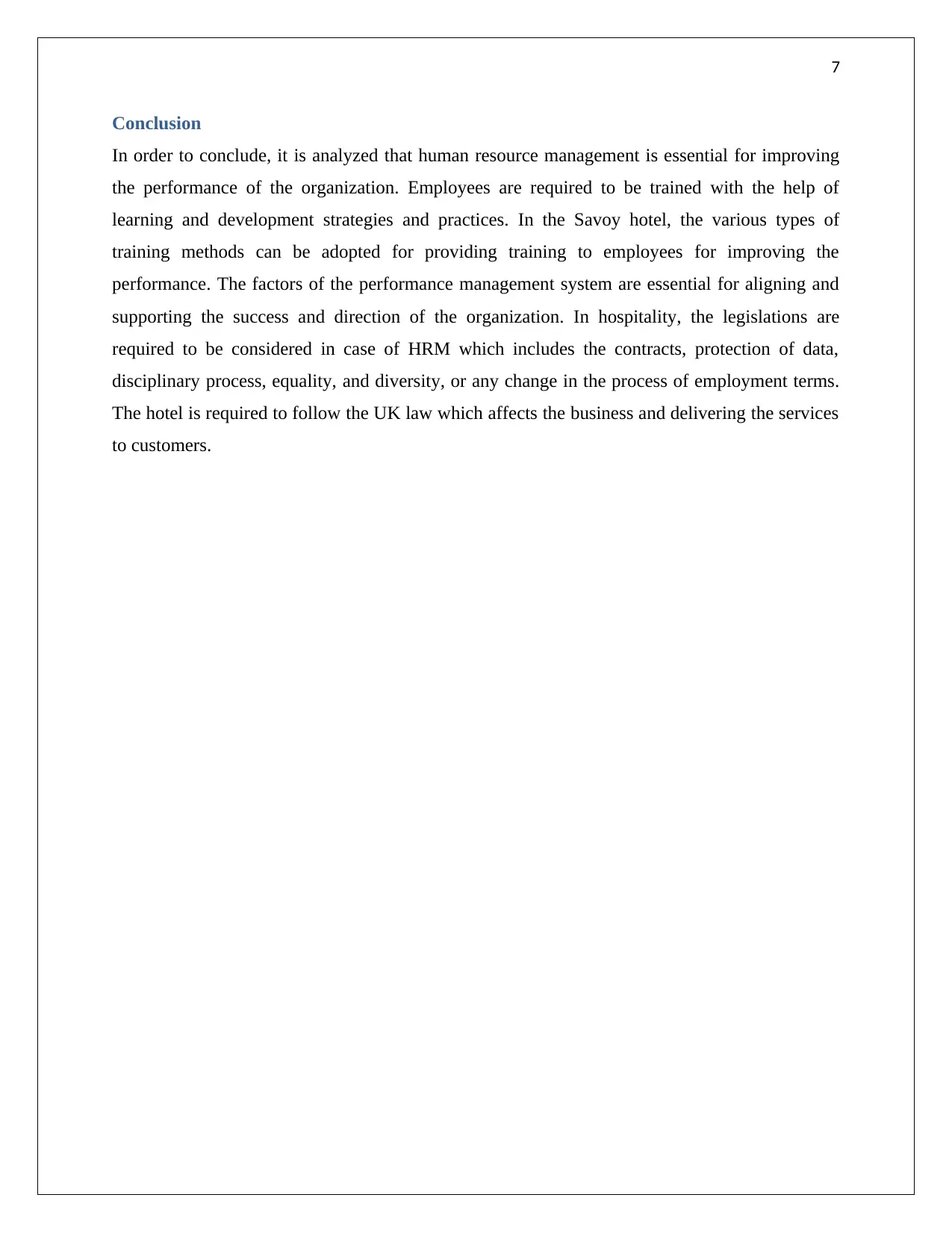
7
Conclusion
In order to conclude, it is analyzed that human resource management is essential for improving
the performance of the organization. Employees are required to be trained with the help of
learning and development strategies and practices. In the Savoy hotel, the various types of
training methods can be adopted for providing training to employees for improving the
performance. The factors of the performance management system are essential for aligning and
supporting the success and direction of the organization. In hospitality, the legislations are
required to be considered in case of HRM which includes the contracts, protection of data,
disciplinary process, equality, and diversity, or any change in the process of employment terms.
The hotel is required to follow the UK law which affects the business and delivering the services
to customers.
Conclusion
In order to conclude, it is analyzed that human resource management is essential for improving
the performance of the organization. Employees are required to be trained with the help of
learning and development strategies and practices. In the Savoy hotel, the various types of
training methods can be adopted for providing training to employees for improving the
performance. The factors of the performance management system are essential for aligning and
supporting the success and direction of the organization. In hospitality, the legislations are
required to be considered in case of HRM which includes the contracts, protection of data,
disciplinary process, equality, and diversity, or any change in the process of employment terms.
The hotel is required to follow the UK law which affects the business and delivering the services
to customers.
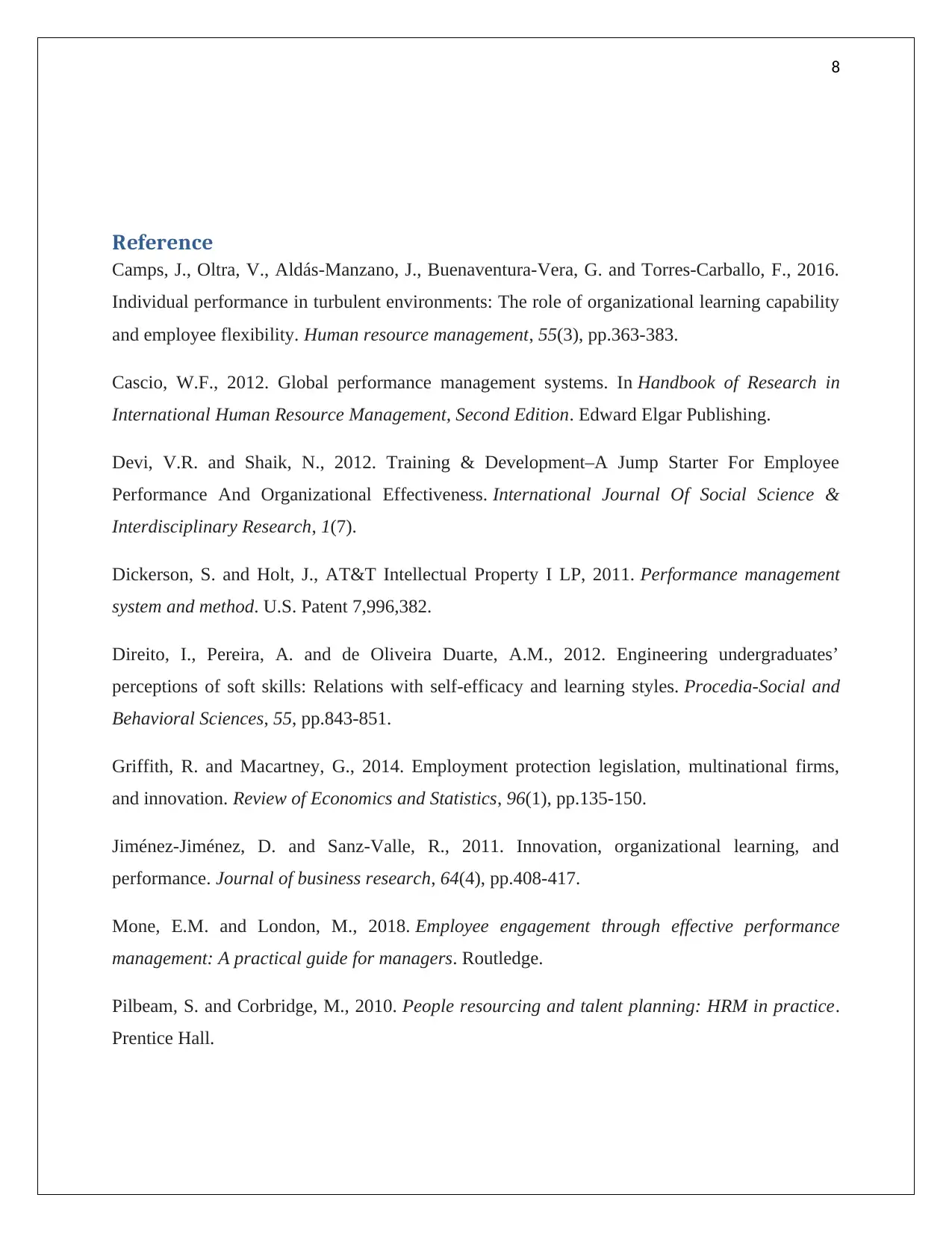
8
Reference
Camps, J., Oltra, V., Aldás‐Manzano, J., Buenaventura‐Vera, G. and Torres‐Carballo, F., 2016.
Individual performance in turbulent environments: The role of organizational learning capability
and employee flexibility. Human resource management, 55(3), pp.363-383.
Cascio, W.F., 2012. Global performance management systems. In Handbook of Research in
International Human Resource Management, Second Edition. Edward Elgar Publishing.
Devi, V.R. and Shaik, N., 2012. Training & Development–A Jump Starter For Employee
Performance And Organizational Effectiveness. International Journal Of Social Science &
Interdisciplinary Research, 1(7).
Dickerson, S. and Holt, J., AT&T Intellectual Property I LP, 2011. Performance management
system and method. U.S. Patent 7,996,382.
Direito, I., Pereira, A. and de Oliveira Duarte, A.M., 2012. Engineering undergraduates’
perceptions of soft skills: Relations with self-efficacy and learning styles. Procedia-Social and
Behavioral Sciences, 55, pp.843-851.
Griffith, R. and Macartney, G., 2014. Employment protection legislation, multinational firms,
and innovation. Review of Economics and Statistics, 96(1), pp.135-150.
Jiménez-Jiménez, D. and Sanz-Valle, R., 2011. Innovation, organizational learning, and
performance. Journal of business research, 64(4), pp.408-417.
Mone, E.M. and London, M., 2018. Employee engagement through effective performance
management: A practical guide for managers. Routledge.
Pilbeam, S. and Corbridge, M., 2010. People resourcing and talent planning: HRM in practice.
Prentice Hall.
Reference
Camps, J., Oltra, V., Aldás‐Manzano, J., Buenaventura‐Vera, G. and Torres‐Carballo, F., 2016.
Individual performance in turbulent environments: The role of organizational learning capability
and employee flexibility. Human resource management, 55(3), pp.363-383.
Cascio, W.F., 2012. Global performance management systems. In Handbook of Research in
International Human Resource Management, Second Edition. Edward Elgar Publishing.
Devi, V.R. and Shaik, N., 2012. Training & Development–A Jump Starter For Employee
Performance And Organizational Effectiveness. International Journal Of Social Science &
Interdisciplinary Research, 1(7).
Dickerson, S. and Holt, J., AT&T Intellectual Property I LP, 2011. Performance management
system and method. U.S. Patent 7,996,382.
Direito, I., Pereira, A. and de Oliveira Duarte, A.M., 2012. Engineering undergraduates’
perceptions of soft skills: Relations with self-efficacy and learning styles. Procedia-Social and
Behavioral Sciences, 55, pp.843-851.
Griffith, R. and Macartney, G., 2014. Employment protection legislation, multinational firms,
and innovation. Review of Economics and Statistics, 96(1), pp.135-150.
Jiménez-Jiménez, D. and Sanz-Valle, R., 2011. Innovation, organizational learning, and
performance. Journal of business research, 64(4), pp.408-417.
Mone, E.M. and London, M., 2018. Employee engagement through effective performance
management: A practical guide for managers. Routledge.
Pilbeam, S. and Corbridge, M., 2010. People resourcing and talent planning: HRM in practice.
Prentice Hall.
⊘ This is a preview!⊘
Do you want full access?
Subscribe today to unlock all pages.

Trusted by 1+ million students worldwide
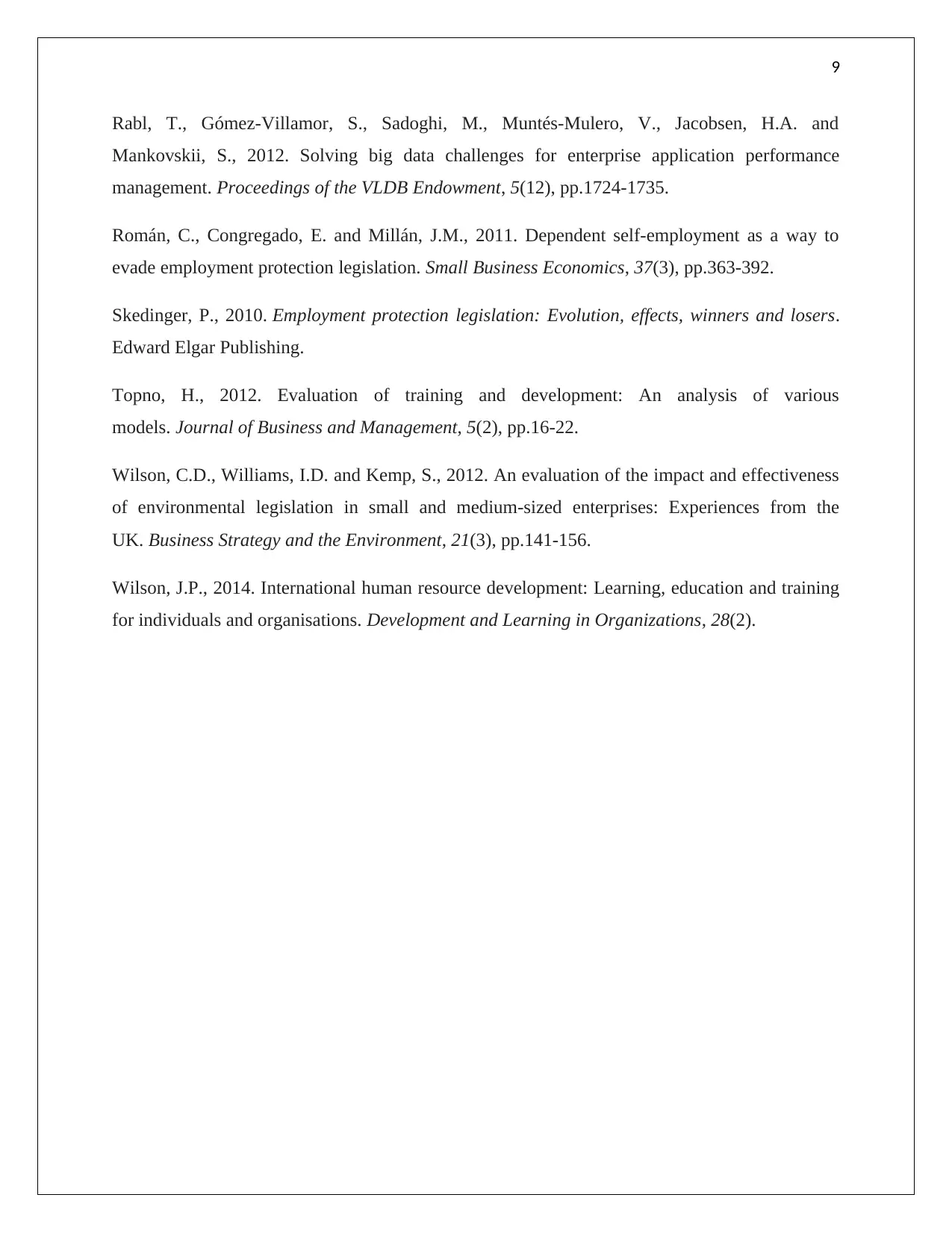
9
Rabl, T., Gómez-Villamor, S., Sadoghi, M., Muntés-Mulero, V., Jacobsen, H.A. and
Mankovskii, S., 2012. Solving big data challenges for enterprise application performance
management. Proceedings of the VLDB Endowment, 5(12), pp.1724-1735.
Román, C., Congregado, E. and Millán, J.M., 2011. Dependent self-employment as a way to
evade employment protection legislation. Small Business Economics, 37(3), pp.363-392.
Skedinger, P., 2010. Employment protection legislation: Evolution, effects, winners and losers.
Edward Elgar Publishing.
Topno, H., 2012. Evaluation of training and development: An analysis of various
models. Journal of Business and Management, 5(2), pp.16-22.
Wilson, C.D., Williams, I.D. and Kemp, S., 2012. An evaluation of the impact and effectiveness
of environmental legislation in small and medium‐sized enterprises: Experiences from the
UK. Business Strategy and the Environment, 21(3), pp.141-156.
Wilson, J.P., 2014. International human resource development: Learning, education and training
for individuals and organisations. Development and Learning in Organizations, 28(2).
Rabl, T., Gómez-Villamor, S., Sadoghi, M., Muntés-Mulero, V., Jacobsen, H.A. and
Mankovskii, S., 2012. Solving big data challenges for enterprise application performance
management. Proceedings of the VLDB Endowment, 5(12), pp.1724-1735.
Román, C., Congregado, E. and Millán, J.M., 2011. Dependent self-employment as a way to
evade employment protection legislation. Small Business Economics, 37(3), pp.363-392.
Skedinger, P., 2010. Employment protection legislation: Evolution, effects, winners and losers.
Edward Elgar Publishing.
Topno, H., 2012. Evaluation of training and development: An analysis of various
models. Journal of Business and Management, 5(2), pp.16-22.
Wilson, C.D., Williams, I.D. and Kemp, S., 2012. An evaluation of the impact and effectiveness
of environmental legislation in small and medium‐sized enterprises: Experiences from the
UK. Business Strategy and the Environment, 21(3), pp.141-156.
Wilson, J.P., 2014. International human resource development: Learning, education and training
for individuals and organisations. Development and Learning in Organizations, 28(2).
1 out of 10
Related Documents
Your All-in-One AI-Powered Toolkit for Academic Success.
+13062052269
info@desklib.com
Available 24*7 on WhatsApp / Email
![[object Object]](/_next/static/media/star-bottom.7253800d.svg)
Unlock your academic potential
Copyright © 2020–2025 A2Z Services. All Rights Reserved. Developed and managed by ZUCOL.





